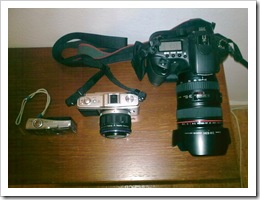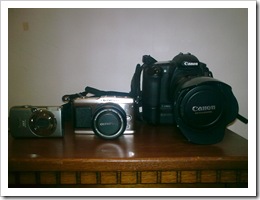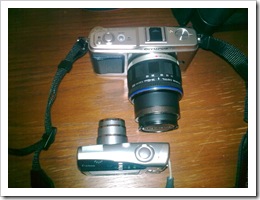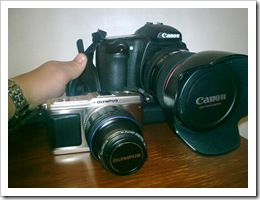The E-P1 is clearly the most talked about camera for quite a while, and as such, some people have built up unsustainable expectations about what it would be. Some people have believed that since it has a large sensor and interchangeable lenses, it will be equivalent to an SLR in every aspect. Now that it’s out, and reality shows it’s harsh face, love turns into hate. There are a lot of people on the internet bemoaning the camera as unusable, a fiasco, and the death blow to Olympus. I believe them to be wrong, silly and perhaps a bit stupid.
I believe I had a more realistic expectation about what type of compromises would be necessary to create this type of camera, and as such, I am far more pleased with the results. As far as I can see to date, the E-P1 matches my expectations quite well.
There are basically three main differences between a compact camera (of today) and an SLR. Image quality, autofocus, and speed.
An SLR can take images with better dynamic range, clearer colors, less noise, and finer details than a compact. Images can also be given a shallow depth of field to achieve a classic, artistic look that is impossible to create with a compact. In essence and slightly simplified, this image quality comes down to the sensor, and to a great degree the size of the sensor, combined with the ability to choose the correct lens for the situation instead of using a jack-of-all-trades integrated lens. In this, and only this, aspect, the E-P1 is comparable with a current entry-level SLR.
No compact camera can obtain sharp focus of a moving object with low contrast in bad lighting. And in the cases focus can be acquired, it will be slow since the lens has to “move past” correct focus to find where it had the highest contrast, and then move back. SLRs (when not in live view mode) use a fundamentally different system where light from the lens is diverted (and divided) to separate autofocus sensors through a set of mirrors/prisms. This phase detect system is impossible without the mirrors, and the entire concept of micro 4/3 is the lack of mirror, so of course the E-P1 would be lacking compared to an SLR in this aspect. Of course it would be like any other compact. In fact, it’s an engineering feat that it isn’t vastly inferior to other good compacts, since the compacts with smaller sensors have smaller apertures which will automatically mask a slight missfocus with a large depth of field, something which would require a lot of stopping down with the E-P1.
Finally, one of the joys with a good SLR is the immediacy of its’ operation. Even apart from the fast focusing, there are basically no other perceivable slowdowns that prevent you from getting a picture. If I’m holding my 20D and see something interesting happening, I can go from off to picture taken in maybe half a second, depending on how fast I can point my camera in the right direction. If I was holding the E-P1 it would take maybe 3 seconds to start the camera, focus and shoot. Most likely, I would have missed the shot. And if I take a picture, it will take me a few seconds until I can take the next one. The 20D will let me take a new picture as fast as my finger can press the shutter button again. I’m slightly let down that the E-P1 isn’t faster, but only slightly.
The single most notable difference, however, is looking at an LCD compared to looking through an optical viewfinder. Before the image can be displayed on the LCD, it has to be captured on the sensor, demosaiced, processed, downscaled and brightness compensated. That’s a lot of calculation, and sure, a faster processor would speed it up a bit, but if we had an i7 in there the battery life would be counted in minutes. Finally, the image has to be sent to the LCD, which in and of itself has a latency before the liquid crystals can be rearranged.
All this means that what you see on the LCD doesn’t reflect reality right now, but rather a while ago when the image was captured on the sensor, before all that calculations etc. As far as I can tell this lag seems to be somewhere between 0.1 and 0.2 seconds, which is really fast by compact standards. By comparison however, when looking through an optical viewfinder, the only thing slowing the image down is the speed of light… what you see is what is happening right now.
So in the most important performance aspect, the E-P1 makes an unexpectedly good showing (perhaps the low resolution screen was a compromised Olympus had to make to achieve this low lag, in which case I think it was clearly the right decision). But naturally it can’t compete with an SLR. The laws of physics prevent it.
As I said, none of these shortcomings surprised me. I don’t count any of them as failings of the camera, but rather design decisions necessary to allow it to be better than an SLR in some ways. Better in term of small size, particularly, and better in terms of aesthetics (it doesn’t look like a toy, as most similarly priced SLRs do).
So all in all, of course the E-P1 is a compromise. I think it’s a really good compromise. This camera will be with me in situations where I otherwise would have been without a camera, and as such the compromises will allow me to capture images I would have otherwise missed. But I can’t for my life imagine getting rid of my SLR, nor did I ever. As always, the right tool in the right situation will win.




